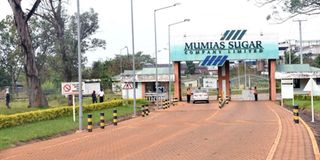Mumias too big to be left to die

The main gate to Mumias Sugar Company in this picture taken on August 2018.
What you need to know:
- Mumias was put under receivership by Kenya Commercial Bank on September 20, 2019.
- Today, the only operational section of the factory is the ethanol distillery.
Is Mumias Sugar Company likely to resume full operations soon? I don’t think so. If anything, I see the company facing the same fate as PanPaper, which is yet to resume full operations more than five years after it came out of receivership.
Mumias was put under receivership by Kenya Commercial Bank on September 20, 2019. Today, the only operational section of the factory is the ethanol distillery, most of whose revenues end up being eaten up by the receivers’ fees.
But the last time I checked, even the distillery’s operations were facing immense pressure due to an acute shortages of molasses.
Is it not really the height of irony that a factory that used to be the largest producer of sugar in East Africa is down to the level where it has to scrounge for molasses?
The mill is literally rotting away even as the receivers and the government continue procrastinating and dithering over how and when to choose a private party to pump cash into it to revive the mill and rehabilitate its 10,000-acre nucleus estate.
Technically, the government, despite being the single largest shareholder in the company, does not have a say on its fate. The company is legally in the hands of its lenders. It is insolvent and shareholder capital in the negative.
Yet the reason why quick resolution on the matter has not been possible is politics and roadblocks by the government. At one stage early last year, authoritative sources close to the receivers were intimating to me that the recruitment of an investor to run Mumias Sugar was a done deal.
Reviving the mill
Apparently, the receivers had concluded negotiations with a company by the name Sarrai Group, which owns and operates Hoima Sugar in western Uganda, which sits on a 60,000-acre sugar plantation.
Sarrai was to be given a long-term lease with an option to buy both the nucleus estate and the factory. I hear that the decision is pending at the board of the bank.
The procrastination about when and which company to choose has provided a window to all manner of pretenders to political power in western Kenya to exert pressure on the receivers and influence the choice of the investor. I’m told the receivers are under pressure to open the field for more players to put in bids.
Clearly, the task of procuring an investor with pockets deep enough to invest in reviving the mill is not going to be easy.
We want a player with demonstrable capacity and experience and capable of pumping in cash in rehabilitating nucleus plantation of Mumias and making local smallholder farming profitable once again.
This transaction must, of essence, be completed quickly as we cannot allow the mill to continue rusting. We need to get the receivers out of Mumias Sugar quickly.
But even as we bring in an investor, priority must be given to supporting the sugarcane farmer. We want an investor who will pay farmers on time and not charge them exorbitantly for tractor and transport services.
We must demand a return to subsidised credit and systems where money due to farmers is not deducted to pay for corruptly procured and expensive fertiliser and inputs.
Displacement of populations
Indeed, the biggest irony in the Mumias saga is that, instead of the cane farmer making money, it is the distributors, transporters and their political allies in Nairobi who were minting the billions.
No cash crop has created more misery and suffering to the sugar farmer in Kakamega, Trans Nzoia, Kisumu and Migori counties than sugarcane.
In the 1960s and ’70s, thousands of households and rural poor were induced by money to vacate the only pieces of land they owned to give way to nucleus estates. Hundreds of thousands of rural folk were pushed into joining the ranks of the urban poor in overcrowded rural towns such as Mumias, Awendo and Muhoroni with no proper public amenities.
In those days, projects involving massive displacement of rural populations proceeded without any thought to mitigation measures or safety nets. The fancy idea of supporting ‘project-affected persons’ came the other day.
However, the compensation given was a pittance. The money was squandered in conspicuous consumption and in marrying more wives.
Years later, there emerged the phenomenon called the out-grower zone company. These were corrupt and inefficiently managed entities that hurt the cane farmer by dumping on to them expensive fertiliser, usurious loans, exorbitant ploughing rates and high transport charges.
The sugar mills themselves became vampires that sucked the blood of the farmer through rigged weighbridges, poor producer prices and delayed payments.
Mumias Sugar is just too important to the economy and the livelihoods of the people of western Kenya to be left to die.





